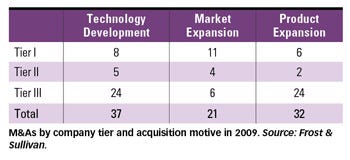Companies are likely to turn toward mergers and acquisitions (M&As) over the next four years to overcome the negative effects of the economic recession.
July 1, 2010
 Companies are likely to turn toward mergers and acquisitions (M&As) over the next four years to overcome the negative effects of the economic recession. According to a report from Frost & Sullivan, “Consolidation/M&A in Medical Imaging Market,” “Takeovers are a quick and cheap way for healthcare companies to expand their market share.” Additionally, the downturn is making it possible for companies to acquire imaging manufacturers at bargain prices.
Companies are likely to turn toward mergers and acquisitions (M&As) over the next four years to overcome the negative effects of the economic recession. According to a report from Frost & Sullivan, “Consolidation/M&A in Medical Imaging Market,” “Takeovers are a quick and cheap way for healthcare companies to expand their market share.” Additionally, the downturn is making it possible for companies to acquire imaging manufacturers at bargain prices.
To examine M&A activity, Frost & Sullivan selected a group of medical imaging companies and classified them as either tier I, II, or III. Tier I companies, such as Philips Healthcare and GE Healthcare, are defined as having high revenues and a wide range of product offerings. The tier II companies (e.g., Hitachi and Toshiba Medical Systems) have a “notable presence in the medical image market in terms of revenues,” the report says, as well as a product portfolio that spans most segments of the imaging market. Tier III companies (3Mensio and SonoSite) offer fewer products and are generally more focused on selected segments.
Frost & Sullivan analyzed M&As in Europe among the selected companies and characterized their motive for the action as based on one of three goals: technology development, market expansion, or product expansion. For 2009, it found that a total of 90 M&As had been made. The motive for the majority of that activity was identified as technology development; however, tier I companies were more likely to be driven by market expansion. See Table I for a detailed breakdown of M&As and motive.
$5.7 billion |
According to Frost & Sullivan, the recession has forced companies in all three tiers to adopt different survival strategies. Although tier II companies have maintained revenues and avoided being swallowed by larger companies, the economic downturn has “severely limited their ability to compete with tier I companies in the M&As sector.” Frost & Sullivan says that, going forward, unless tier II companies can acquire tier III companies, many are likely to be consolidated with larger industry players.
Consolidation is also likely to affect tier III companies, which were subject to the most M&A activity in 2009. “Tier III companies will be acquired for their technological developments and distribution channels, further increasing the domination of the tier I companies,” the report says.
In the coming years, tier I companies are also expected to increase their influence by expanding into emerging markets. Stimulus plans in Mexico and Brazil have elevated imaging manufacturers’ interest in acquiring local companies. Likewise, tier I players, such as Philips Healthcare, are obtaining distribution and sales units in Russia, where reforms are expected to double the country’s healthcare market, Frost & Sullivan says. Additionally, the large populations of China and India make these countries ripe for future M&A activity.
The organic expansion of medical imaging companies could soon be regarded as an outdated strategy. “Companies need not waste time and money or take the risk to try and expand organically with so many attractive targets available at bargain prices,” Frost & Sullivan concludes.
About the Author(s)
You May Also Like


